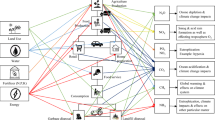Abstract
The pairing of foods and beverages (especially alcoholic beverages) is an effective marketing approach to promote the value of Japanese gastronomy to overseas consumers because it requires little additional cost. In this study, the research target was French consumers, and the evaluation targets were grilled fall-season wild chum salmon from Japan (mainly from Hokkaido) and Japanese rice wine (sake). The difference in the consumers’ willingness to pay (WTP) was evaluated using the contingent valuation method. In addition, we analyzed the determinants by applying Tobit regression. Our results revealed that there was a higher WTP when Japan’s (Hokkaido’s) grilled fall salmon and sake were presented as a set than when they were presented individually. The geographical identity of the origin of food and beverages can engender a positive premium to consumers through the synergistic effect of the origin of the brand.



Similar content being viewed by others
References
Amemiya T (1973) Regression analysis when the dependent variable is truncated normal. Econometrica 41:997–1016
Baum CF, Schaffer ME, Stillman S (2011) Using stata for applied research: reviewing its capabilities. J Econ Surv 25(2):380–394
Bode WKH (1992) The marriage of food and wine. Int J Wine Mark 4(2):15–20
Castellari E, Marette S, Moro D, Sckokai P (2019a) The impact of information on willingness to pay and quantity choices for meat and meat substitute. J Agric Food Industrial Organization 17(1):1–16
Castellari E, Ricci EC, Stranieri S, Marette S, Sarnataro M, Soregaroli C (2019b) Relationships between health and environmental information on the willingness to pay for functional foods the case of a new aloe vera based product. Nutrients 11(11):2781 (1–16)
Eschevins A, Giboreau A, Julien P, Dacremont C (2019) From expert knowledge and sensory science to a general model of food and beverage pairing with wine and beer. Int J Gastron Food Sci 17(100144):1–10
Fujita A (2012) White wine and sake pairings with seafood: effects of sulfur dioxide on formation of fishy off-odor and undesirable taste. J Brew Soc Japan 106(5):271–279 (in Japanese)
Gagić S, Ivkov M. (2013) Food and wine pairing-six course menu example, Hotelplan 2013 congress proceedings, Belgrade, Serbia, 28th-29th November: 451–462
Ichijo A (2017) Banal nationalism and UNESCO’s intangible cultural heritage list: cases of washoku and the gastronomic meal of the french. In: Skey M, Antonsich M (eds) Everyday nationhood theorising culture, identity and belonging after banal nationalism. Palgrave Macmillan, London, UK, pp 259–284
Kim S, Lecat B (2017) An exploratory study to develop Korean food and wine pairing criteria. Beverages 3(40):1–19
Kitano S, Yamamoto N (2020) The role of consumer knowledge, experience, and heterogeneity in fish consumption: policy lessons from Japan. J Retail Consum Serv 56(102151):1–15
Kohsaka R (2017) The myth of washoku: a twisted discourse on the ‘uniqueness’ of national food heritages. J Ethnic Foods 4:66–71
Kokthi E, Kruja D (2017) Consumer expectations for geographical origin: eliciting willingness to pay (WTP) using the disconfirmation of expectation theory (EDT). J Food Products Marketing 23(8):873–889
Kuroda T (2012) Sake in France: importer’s observations. J Brew Soc Japan 111(1):14–21 (in Japanese)
Li C, Bai J, Gao Z, Fu, J (2017) Willingness to pay for “taste of Europe”: geographical origin labeling controversy in China Br Food J 119(8):1897–1914
McDonald JF, Moffitt RA (1980) The uses of tobit analysis. Rev Econ Stat 62:318–321
Okello J, Hutchinson M, Mwangombe A, Ambuko J, Olubayo F, Mwakangalu M (2015) Consumer demand for value-added products of African indigenous vegetables in coastal kenya: the case of sun-dried and frozen cowpea leaves. J Agric, Food Syst, Commun Dev 6(1):189–207
Otsuka S (1975) Cultural history of food (Shoku no Bunkashi). Chuoukouronsha, Tokyo, JPN, pp 1–186
Pettingrew S, Charters S (2006) Consumers’ expectations of food and alcohol pairing. Br Food J 108(3):169–180
Rihn A, Yue C (2016) Visual attention’s influence on consumers’ willingness-to-pay for processed food products. Agribusiness 32(3):314–328
Sabre C (2013) New images of Japan in France: a survey to Japan EXPO. In: Koma K (ed) Representations of Japanese popular culture in Europe. Vytautas Magnus University Press, Kaunas, LT, pp 95–122
Serra M, Antonio N, Henriques C, Afonso CM (2021) Promoting sustainability through regional food and wine pairing. Sustainability 13(13759):1–22
Tobin J (1958) Estimation of relationships for limited dependent variables. Econometrica 26(1):24–36
Utsunomiya H, Hashizume K (2009) Investigation of consumers motives for their choice of sake, beer, and whisky. J Brew Soc Japan 104(3):170–181 (in Japanese)
Yang X, Cheng L, Yin C, Lebailly P, Azadi H (2018) Urban residents’ willingness to pay for corn straw burning ban in Henan, China: application of payment card. J Clean Prod 193:471–478
Acknowledgements
We would like to thank the two reviewers for their helpful comments during the peer review of this study. This work was supported by JSPS KAKENHI (16H02565, 21H04738) and a project of the Policy Research Institute, Ministry of Agriculture, Forestry, and Fisheries (Grant No. 20353867).
Author information
Authors and Affiliations
Corresponding author
Additional information
Publisher’s Note
Springer Nature remains neutral with regard to jurisdictional claims in published maps and institutional affiliations.
Rights and permissions
Springer Nature or its licensor holds exclusive rights to this article under a publishing agreement with the author(s) or other rightsholder(s); author self-archiving of the accepted manuscript version of this article is solely governed by the terms of such publishing agreement and applicable law.
About this article
Cite this article
Oishi, T., Sugino, H. & Yagi, N. French consumers’ marginal willingness to pay for the pairing of Japan’s fall chum salmon and rice wine (sake). Fish Sci 88, 845–856 (2022). https://doi.org/10.1007/s12562-022-01637-7
Received:
Accepted:
Published:
Issue Date:
DOI: https://doi.org/10.1007/s12562-022-01637-7




